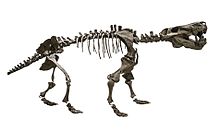| Gorgonopsians Temporal range: Middle Permian - Late Permian,
| |
|---|---|

| |
| Skeleton of Inostrancevia alexandri at the Museo delle Scienze, Trento, Italy | |
| Scientific classification | |
| Domain: | Eukaryota |
| Kingdom: | Animalia |
| Phylum: | Chordata |
| Clade: | Synapsida |
| Clade: | Therapsida |
| Clade: | Theriodontia |
| Clade: | †Gorgonopsia Seeley, 1895 |
| Genera | |
Gorgonopsia (from the Greek Gorgon, a mythological beast, and óps 'aspect') is an extinct clade of sabre-toothed therapsids from the Middle to the Upper Permian, roughly between 265 and 252 million years ago. They are characterised by a long and narrow skull, as well as elongated upper and sometimes lower canine teeth and incisors which were likely used as slashing and stabbing weapons. Postcanine teeth are generally reduced or absent. For hunting large prey, they possibly used a bite-and-retreat tactic, ambushing and taking a debilitating bite out of the target, and following it at a safe distance before its injuries exhausted it, whereupon the gorgonopsian would grapple the animal and deliver a killing bite. They would have had an exorbitant gape, possibly in excess of 90°, without having to unhinge the jaw.
They markedly increased in size as time went on, growing from small skull lengths of 10–15 cm (4–6 in) in the Middle Permian to bear-like proportions of up to 60 cm (2 ft) in the Upper Permian. The latest gorgonopsians, Rubidgeinae, were the most robust of the group and could produce especially powerful bites. Gorgonopsians are thought to have been completely terrestrial and could walk with a semi-erect gait, with a similar terrestrial locomotory range as modern crocodilians. They may have been more agile than their prey items, but were probably inertial homeotherms rather than endotherms unlike contemporary therocephalians and cynodonts, and thus were probably comparatively less active. Though gorgonopsians were able to maintain a rather high body temperature, it is unclear if they would have also had sweat glands or fur (and by extension whiskers and related structures). Their brains were reminiscent of modern reptilian brains, rather than those of living mammals. Most species may have been predominantly diurnal (active during the day) though some could have been crepuscular (active at dawn or dusk) or nocturnal (active at night). They are thought to have had binocular vision, a parietal eye (which detects sunlight and maintains circadian rhythm), a keen sense of smell, a functional vomeronasal organ ("Jacobson's organ"), and possibly a rudimentary eardrum.
The major therapsid groups had all evolved by 275 million years ago from a "pelycosaur" ancestor (a poorly defined group including all synapsids which are not therapsids). The therapsid takeover from pelycosaurs took place by the Middle Permian as the world progressively became drier. Gorgonopsians rose to become apex predators of their environments following the Capitanian mass extinction event which killed off the dinocephalians and some large therocephalians after the Middle Permian. Despite the existence of a single continent during the Permian, Pangaea, gorgonopsians have only been found in the Karoo Supergroup (primarily in South Africa, but also in Tanzania, Zambia, and Malawi), the Moradi Formation of Niger, western Russia, and in the Turpan Basin of Xinjiang, China, with probable remains known from the Kundaram Formation in the Pranhita–Godavari Basin of India. These places were semi-arid areas with highly seasonal rainfall. Gorgonopsian genera are all very similar in appearance, and consequently many species have been named based on flimsy and likely age-related differences since their discovery in the late 19th century, and the group has been subject to several taxonomic revisions.
Most gorgonopsians became extinct during a phase of the Permian–Triassic extinction event taking place at the very end of the Permian, in which major volcanic activity (which would produce the Siberian Traps) and resultant massive spike in greenhouse gases caused rapid aridification due to temperature spike, acid rain, frequent wildfires, and potential breakdown of the ozone layer. However, some smaller taxa like Cyonosaurus may have survived up to the Early Triassic. The large predatory niches would be taken over by the archosaurs (namely crocodilians and dinosaurs) in the Mesozoic.